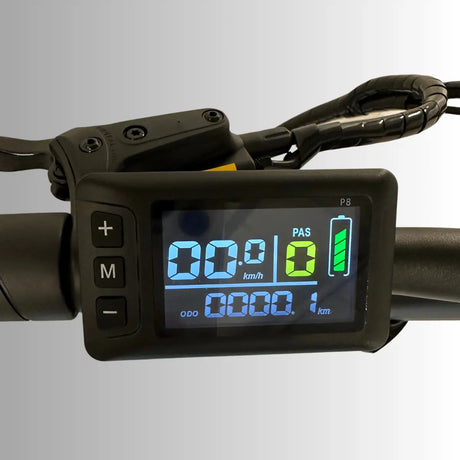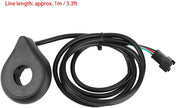Inside this Article:
- Understanding eBike Batteries
- Signs of a Healthy eBike Battery
- Tools and Equipment for Checking Battery Health
- A Step-by-Step Guide to Checking eBike Battery Health
- 1. Visual Inspection
- 2. Measuring Voltage
- 3. Checking Battery Capacity
- 4. Analyzing Charge Cycles
- 5. Using Battery Management Systems (BMS)
- 6. Smartphone Apps and Diagnostic Software
- Common Indicators of Battery Health Issues
- 1. Rapidly Decreasing Battery Life
- 2. Battery Swelling or Physical Damage
- 3. Overheating During Use or Charging
- 4. Irregular Charge Times
- Regular Maintenance Tips for Prolonging Battery Life
- How to Handle and Dispose of Damaged Batteries
- Summary
- Frequently Asked Questions (FAQs)
- How Often Should I Check My eBike Battery Health?
- What Are the Most Common Causes of Battery Degradation?
- Can I Replace My eBike Battery Myself?
- What Are the Best Practices for Storing an eBike Battery Long-term?
- How Do I Know When It's Time to Replace My eBike Battery?
- How do I test my eBike battery?
- How do I know if my eBike battery needs to be replaced?
- How do I check my bike battery health?
- How do I know if my eBike battery is safe?
Perhaps you’ve noticed a drop in your electric bike’s range and how it’s not sprinting up hills with the same gusto as before. In that case, it might be time to glance at your bike’s battery health. Knowing how to check ebike battery health and monitoring and maintaining the battery is key to ensuring your bike continues to be a reliable and energetic companion on your rides. This isn't just about saving money; it's about maximising your vehicle's performance and lifespan.
Whether you’re a daily commuter or a weekend trail explorer, there’s not much you can do with your two-wheeled wonder if it consistently breaks down or doesn’t cover ground like before. But fear not; we have an answer to all your questions and concerns. Keep reading as we delve into the likes of checking e-bike battery health, methods and tools required to assess its condition, common battery issues, and much more.
Understanding eBike Batteries
Before you inspect your e-bicycle battery health, it's crucial to understand some basic battery terminology so you know what to look for:
Basic Battery Terminology
Let's start with the essentials of battery technology that will be foundational for the rest of our discussion:
Voltage
Voltage is the measure of the electrical potential of a battery and is the pressure that pushes electrical current through the bike’s system. Higher voltage means more power, enabling your pedelec or eMTB to tackle steep hills or accelerate quickly. Most e-bikes operate on 36 to 48 volts, which offers a balance of power and efficiency suitable for various riding conditions.
Capacity
This refers to the amount of energy a battery can store, measured in ampere-hours (Ah). Capacity determines how far you can go on a single charge. A higher capacity battery doesn’t necessarily mean a faster bike, but it does mean you can enjoy longer rides without worrying about recharging.
Charge Cycles
A charge cycle counts each time a battery goes from fully charged to fully depleted, then back to fully charged again. Understanding charge cycles is important because it helps predict the lifespan of your battery. Most e-bike batteries are good for several hundred to over a thousand cycles before their capacity significantly decreases, affecting your riding distance and experience.
Signs of a Healthy eBike Battery
Knowing how to interpret the signs of a healthy battery can save you from unexpected breakdowns and ensure you're getting the most out of your cycling adventures:
1. Expected Performance Levels
A good-quality electric bicycle battery typically delivers consistent and predictable performance. Consequently, your bike should be able to reach the speeds and power outputs specified by the manufacturer without any hassle. If your e-bike consistently meets or exceeds these performance expectations, it's a good indication that your battery is in top shape.
2. Normal Charge and Discharge Rates
The rate at which your battery charges and discharges can tell you a lot about its condition. A healthy battery will charge at the rate specified by the manufacturer and hold that charge during use, according to its capacity. Batteries that take significantly longer to charge or discharge too quickly during rides indicate signs of ageing or damage.
3. Consistent Battery Life
Consistency in how long your battery lasts from one charge to the next is a key indicator of health. If your pedelec’s battery life starts fluctuating significantly — for instance, if it suddenly doesn't last as long on a charge as it used to under similar riding conditions — this could be a sign that the battery is declining in health. Your battery should maintain a consistent output without showing drastic changes in longevity unless there’s a change in riding habits or conditions.
Tools and Equipment for Checking Battery Health
The right tools and equipment not only help diagnose potential issues with your battery but also guarantee it operates within optimal parameters:
1. Multimeters
A multimeter is a fundamental tool for any electric bike owner. It measures voltage, current, and resistance, which are critical for assessing your battery's condition. Use a multimeter to check the voltage of your battery to ensure it matches what’s expected based on the battery’s specifications. This can help you determine if the battery is capable of holding a charge as intended.
2. Battery Management System (BMS) Tools
BMS manages the charge and discharge, ensures cells are balanced, and protects the battery from operating outside its safe parameters. Specialized BMS tools can interface with your e-bike’s BMS to read detailed diagnostics and performance data, offering insights into cell health, energy efficiency, and potential faults.
3. Smartphone Apps and Software
Many modern e-bicycles come with connectivity features that allow you to monitor your battery’s health via smartphone apps or dedicated software. These tools can provide real-time data on your battery’s performance, including its charge level, health status, and efficiency. Some apps also offer troubleshooting guides and maintenance tips based on the data collected from your bike, which makes them a convenient option for regular riders.
A Step-by-Step Guide to Checking eBike Battery Health
In this section, we’ll explore a simple step-by-step guide you can follow to make sure your battery stays in good working condition:
1. Visual Inspection
You should always start with a standard visual inspection of your battery:
Checking for Physical Damage
Look for any signs of wear, tear, or damage and check the battery casing for cracks, dents, or deformities. These physical abnormalities can be indicators of internal issues and may reduce the battery's performance. Further examine the battery for signs of swelling, leakage, or any unusual smells, as this can lead to battery failure. Swelling might suggest that the battery cells have been compromised, potentially due to overcharging, deep discharging, or exposure to extreme temperatures. Additionally, any leakage could corrode internal components and must be addressed immediately.
Inspecting Battery Terminals
Look closely at the battery terminals. Terminals should be clean, free of corrosion, and secure since corroded ones can impair the connection, resulting in poor performance and charging issues. You can clean minor corrosion with a mixture of baking soda and water by applying it gently with a toothbrush and then wiping the terminals clean. Ensure the terminals are dry and secure before reconnecting the battery.
2. Measuring Voltage
With the right tools and a bit of know-how, you can easily monitor your battery's voltage so that it performs as expected:
How to Use a Multimeter
Using a multimeter to check the voltage of your e-bike battery is straightforward but requires careful handling to avoid any electrical mishaps:
- Set Up the Multimeter : Turn your multimeter to the voltage measurement setting. Determine whether it's configured to handle a range that exceeds your battery’s maximum voltage capacity. For most e-bike batteries, a setting that can measure up to 100 volts is sufficient.
- Access the Battery Terminals : Ensure the bike is powered off. Disconnect the battery from the vehicle to prevent any accidental short circuits while measuring.
- Connect the Probes : Attach the red probe to the positive (+) terminal and the black probe to the negative (-) terminal of the battery. A reliable reading is only possible when there is solid contact with the terminals.
- Read and Record the Voltage : Observe the reading on the multimeter display. Note the voltage and compare it with expected values for a fully charged, partially charged, or discharged state according to your battery’s specifications.
Understanding Voltage Readings
Understanding how to measure and interpret the voltage of your pedelec’s battery using a multimeter is a crucial skill for any rider. It allows you to monitor the battery's health closely, ensuring that your journeys remain both safe and efficient. When your battery is healthy and fully charged, the voltage reading should align with or slightly surpass the battery’s rated voltage. For instance, a 48V battery in good condition should display a voltage reading anywhere from 48V to 54V when fully charged.
However, if your multimeter indicates a voltage significantly lower than expected for a charged state, this could signal an issue. Such a reading might suggest that the battery wasn't fully charged, or it could be an early sign that the battery is losing its capacity due to age or internal damage. Perform consistency checks by measuring voltage regularly to remain proactive of your battery’s condition, particularly before and after charging or extensive use. Observing fluctuations or a consistent drop in voltage can provide early warnings of potential battery health problems.
3. Checking Battery Capacity
Battery capacity is a critical metric for understanding how far your e-bike can travel on a single charge. Measuring and interpreting the capacity helps maintain optimal performance and battery longevity:
Methods for Measuring Capacity
You can measure your bike’s capacity through several methods, each providing insights into how much energy the battery can store and deliver:
- Discharge Testing: Discharge testing entails fully charging the battery and then discharging it at a continuous and standard rate until it is completely depleted. The total output (usually measured in watt-hours) gives a direct measure of the battery’s capacity. This test should be done using specialized equipment to monitor the discharge rate and energy output accurately.
- Using a Battery Analyzer: A battery analyzer is a more sophisticated tool that can provide detailed measurements of battery capacity without fully depleting the battery's energy. It tests the battery under various conditions to estimate its health and total capacity.
- Smart BMS (Battery Management System): Most modern electric bikes like road-legal and full-suspension versions come equipped with a smart BMS that can monitor battery health and capacity through software. Accessing the BMS data via a smartphone app or computer software provides real-time analytics about the battery’s capacity and overall health.
Interpreting Capacity Results
It's important to compare the measured capacity with the manufacturer’s specified capacity. Typically, a healthy new battery should closely match or come close to this rated capacity. If your tests reveal that the battery’s capacity is significantly lower than expected, it may indicate wear or internal damage that needs addressing.
Over time, it is normal for a battery's capacity to decrease due to regular use and ageing. Keeping an eye on its gradual decline is essential as it helps you gauge the health and life cycle of your battery. A rapid decrease in capacity, however, might require immediate attention due to underlying serious issues .
4. Analyzing Charge Cycles
Each charge cycle represents a full charge and discharge, which affects the battery's overall lifespan:
How to Access Charge Cycle Information
Accessing charge cycle information can be achieved using different ways, depending on the features available with your e-bicycle battery:
- Battery Management System (BMS): Many batteries are equipped with a BMS for recording data on charge cycles. Riders can obtain this data through a manufacturer's smartphone app or a specific display unit on the bike. The BMS provides detailed insights into the number of cycles the battery has undergone.
- Manufacturer's Software: Some e-bike manufacturers offer proprietary software tools that connect to your battery via a computer. These tools offer a detailed log of charge cycle data and other diagnostic information.
- Third-Party Battery Analyzers: For batteries without advanced BMS capabilities, third-party battery analyzers may be used. They connect to your battery and deliver a readout of various health metrics, including charge cycles.
What Charge Cycles Tell You About Battery Health
When you understand the charge cycle data of an e-bike’s battery , you can get a good idea of its health and longevity. Most pedelec batteries are manufactured to endure a specific number of charge cycles—typically between 500 to 1000—before their capacity starts to significantly degrade. By monitoring the current cycle count, you can effectively estimate the remaining lifespan of your battery.
A higher cycle count usually indicates an older battery, but if it still maintains a strong charge, it is likely to be robust and of high quality. In contrast, a battery capacity that declines rapidly before reaching its expected cycle threshold points to an inherent defect or damage. Additionally, analyzing charge cycle data is instrumental in making informed maintenance or replacement decisions. For example, in the case your battery is approaching the end of its rated cycle life, you should consider replacing it for consistent performance, improved throttle control , and operational efficiency.
5. Using Battery Management Systems (BMS)
Battery management systems not only monitor the battery's charge state and health but also manage its overall performance to ensure safety and extended lifespan:
Overview of BMS Functionality
A BMS is designed to regulate the charging and discharging processes so the battery operates within safe parameters. It continuously monitors various factors such as voltage, current, temperature, and charge state. This helps prevent conditions that could lead to battery damage, such as overcharging, deep discharging, and overheating. The BMS also balances the charge across all cells within the battery pack to promote uniformity in performance and range, preventing the battery from degrading prematurely.
Connecting and Interpreting BMS Data
Connecting to a BMS typically involves using specific software provided by the electric bicycle, battery manufacturer, or a dedicated app that communicates with the BMS via Bluetooth or a physical connection. Once connected, you can access detailed metrics about your battery's performance and condition.
To interpret BMS data, riders need to have an understanding of the following key metrics:
- Voltage and Current : These readings help you see the real-time operating status of the battery. High or erratic voltages might indicate a problem with the battery’s cells.
- Temperature : Consistent monitoring of temperature can alert you to overheating issues , which are critical to address immediately to avoid battery damage.
- Charge State and Health : The BMS shows the charge level (state of charge) and overall health (state of health) of the battery, providing insights into how much energy is available and the battery's capacity relative to its original specifications.
6. Smartphone Apps and Diagnostic Software
In the digital age, smartphone apps and diagnostic software have become invaluable tools that provide detailed insights into your battery's status, predict potential issues, and help you manage your e-bike's performance more effectively:
Popular Apps for Battery Health
Several apps have gained popularity among pedelec users for their ability to dispense detailed battery health data and user-friendly interfaces:
- Battery Management System (BMS) Apps : Many bikes come with a proprietary app designed to interface with their BMS. These apps can show real-time battery charge levels, health status, and usage patterns.
- Voltmeter Apps : Voltmeter apps allow you to connect your smartphone directly to your pedelec’s battery through a hardware interface, monitoring voltage and other electrical parameters.
- E-Bike Range Calculators : This app estimates how far you can ride on a single charge based on current battery status, riding conditions, and historical data.
- Comprehensive E-Bike Management Apps : Some apps offer multiple features like GPS tracking, ride statistics, and battery health monitoring for a holistic view of both your ride and your battery’s performance.
Features to Look For in Diagnostic Software
When choosing diagnostic software for your electric bike, consider the following features to ensure comprehensive and effective battery management:
- Detailed Battery Health Reports : The software should provide detailed insights into battery capacity, charge cycles, voltage levels, and expected lifespan according to current usage patterns.
- Real-Time Monitoring : Look for software that integrates real-time data monitoring to get immediate feedback on your battery's status during rides.
- Predictive Maintenance Alerts : Advanced software can analyze usage patterns and battery conditions, predicting potential issues and prompting preventive maintenance.
- Compatibility with Your E-Bike : Ensure that the software is compatible with your e-bike's hardware and operating system, especially if you are using third-party software.
- User-Friendly Interface : We recommend choosing software that is easy to use and understand, even for riders who are particularly tech-savvy.
Common Indicators of Battery Health Issues
Recognizing the early signs of battery health issues can alert you to potential problems , allowing for timely intervention and maintenance :
1. Rapidly Decreasing Battery Life
One of the most noticeable signs of a failing battery is a rapid decline in the duration it lasts on a single charge. If your battery suddenly isn't holding a charge as long as it used to, or the range of your e-bicycle decreases significantly without a corresponding increase in load or changing terrain, the battery's capacity is likely degrading.
2. Battery Swelling or Physical Damage
Physical changes in the battery, such as swelling, are clear signs of problems. Swelling can occur due to gas buildup within the battery cells, often caused by overcharging, exposure to high temperatures, or internal damage. Any visible deformities, cracks, or leakage from the battery are serious concerns and it should be professionally inspected and replaced to avoid safety hazards .
3. Overheating During Use or Charging
Batteries naturally heat up during charging and use, but excessive heat can indicate issues. In case the battery becomes too hot to touch or you notice excessive heating every time the battery is charged or heavily used, it could be a sign of internal damage or malfunctioning safety mechanisms. Persistent overheating can lead to reduced battery life and pose safety risks.
4. Irregular Charge Times
Inconsistencies in how long it takes to charge the battery can also point to health issues. Perhaps you’ve experienced that charging your battery has become unpredictably fast or slow. In that case, the battery is unable to regulate charge intake effectively due to problems with the battery cells or with the battery management system.
Regular Maintenance Tips for Prolonging Battery Life
To ensure your e-bicycle battery remains healthy and efficient over its lifespan, adopting regular maintenance practices is key:
Proper Charging Practices
Here are some effective strategies for charging your electric bike battery to maintain its functionality and longevity:
- Avoid Complete Discharge : Do not let the battery drain completely. Lithium-ion batteries, which are commonly used in e-bikes, have a longer lifespan when not regularly dropped to zero charge. Additionally, the bike’s BMS shuts down if the battery falls to 0, and you may not be able to charge it again.
- Use the Correct Charger : Always use the charger provided by the manufacturer or one that matches the battery’s specifications. Incorrect chargers can lead to overcharging or insufficient charging, both of which damage the battery.
- Partial Charges are Okay : It's not necessary to fully charge the battery every time. In fact, partial charges help contribute to extending the battery’s overall lifespan.
- Charge in a Safe Environment : Ensure the charging area is cool and dry. High temperatures and humidity may affect the battery's chemistry and lead to degradation.
Storing Your E-Bike Battery
How you store your bike’s battery when it’s not in use can significantly affect its health:
- Optimal Temperature : Store the battery in a cool, dry place, away from extreme temperatures. Ideal storage temperatures are between 10°C and 20°C. E-bikes with folding frames can also be stored inside along with the battery as they take up less space!
- Charge Level for Storage : If you are storing the battery for a long period, keep it charged between 40% and 70%. This charge level is recommended for preserving battery health.
- Regular Check-Ups : Even when you are not using your pedelec, check the battery’s charge every few months and top it up once it falls below 40%.
Routine Inspections and Maintenance
Routine inspections and maintenance of your battery are essential for detecting and addressing potential issues before they escalate into major problems. It's important to conduct regular visual inspections to check for any signs of wear, corrosion, or damage. Pay particular attention to the battery's terminals and connectors. Keeping these components clean and free from corrosion guarantees optimal connectivity and functionality. And if your e-bike system supports software updates, keep the software up-to-date to enhance battery management protocols and overall performance.
For a deeper level of maintenance, consider having your battery professionally inspected at least once a year. Professional technicians can perform a thorough examination and potentially spot issues that may not be immediately apparent. These annual checks enable an electric bike to operate efficiently and safely, leading to enjoyable and reliable adventures wherever you go.
How to Handle and Dispose of Damaged Batteries
Batteries contain hazardous materials and should be treated with care:
Safety Precautions
When dealing with a damaged battery, taking the proper precautions is crucial for preventing accidents or further damage:
- Wear Protective Gear : Use gloves and eye protection when handling damaged batteries to protect against leaks or hazardous chemicals.
- Avoid Direct Contact : If the battery is swollen, leaking, or has a strong odor, avoid direct contact. Place it in a non-conductive container and keep it away from flammable materials.
- Isolate the Battery : Store the damaged battery away from other electronic devices and metals, such as in a cool, dry place until it can be properly disposed of.
- Do Not Attempt Repairs : Never try to repair a damaged battery yourself. This can be dangerous and should only be done by professionals.
Environmental Considerations
Electric bicycles batteries are not biodegradable and contain materials that may be harmful to the environment if not disposed of correctly:
- Avoid Landfills : Never throw a battery in the trash or a landfill. Batteries can leak harmful chemicals into the ground, causing soil and water pollution.
- Prevent Fire Risks : Batteries thrown into general waste may lead to fires at waste facilities. The metals and chemicals inside can react and ignite, which poses serious risks to waste management facilities.
Recycling Programs and Facilities
Recycling is the most responsible way to get rid of damaged e-bike batteries:
- Local Recycling Programs : Check for local regulations and programs dedicated to battery recycling. Many areas have specific drop-off points for hazardous waste.
- Retailer Take-Back : Some bike retailers offer take-back programs for old or damaged batteries, which is often the simplest way to ensure the battery is recycled properly.
- Certified Recycling Facilities : Look for facilities certified to handle electric bike battery recycling. These facilities have the proper tools and knowledge to safely break down and recycle battery components.
Summary
Maintaining and knowing how to check ebike battery health is essential for ensuring optimal performance and extended range on rides. Regular checks, including visual inspections, voltage measurements, and capacity testing, help identify potential issues before they lead to significant problems. Remember to always handle damaged batteries with care and dispose of them through appropriate recycling programs to protect both yourself and the environment. By staying proactive and adhering to best practices in battery management, you can enjoy a reliable and efficient cycling experience.
Frequently Asked Questions (FAQs)
How Often Should I Check My eBike Battery Health?
It's recommended to check your battery's health every three to six months . Regular checks help ensure it performs optimally and identifies potential issues early. By staying proactive, you can significantly extend the life of your battery.
What Are the Most Common Causes of Battery Degradation?
Battery degradation is commonly caused by overcharging, deep discharging, exposure to extreme temperatures, and ageing. Try to avoid these conditions, as they reduce battery capacity and efficiency over time.
Can I Replace My eBike Battery Myself?
You can replace your electric bike battery yourself if you have the right tools and follow the manufacturer's guidelines. Ensure you purchase a compatible battery and handle it with care. Always disconnect the power before attempting replacement for safety.
What Are the Best Practices for Storing an eBike Battery Long-term?
Store the battery in a cool, dry place at a 40-70% charge level. Check and top up the charge every few months to prevent it from dropping too low and damaging the battery. Avoid storing the battery in fully charged or fully depleted states to optimize its lifespan.
How Do I Know When It's Time to Replace My eBike Battery?
Replace your e-bike battery when it no longer holds a charge well, shows a significant decline in range, or exhibits physical signs of damage like swelling or leakage. Regular performance assessments can help determine the appropriate time for replacement.
How do I test my eBike battery?
Use a multimeter to measure the voltage and check if it aligns with the battery's specifications. Discharge tests and using a battery management system can also provide comprehensive health reports, while consistent readings over time are a good indicator of battery health.
How do I know if my eBike battery needs to be replaced?
If your battery shows drastically reduced performance, fails to hold a charge, or has visible damage such as swelling or leakage, it's time for a replacement. A sudden drop in performance after a charge is a clear sign that the battery may be nearing the end of its usable life.
How do I check my bike battery health?
Regularly measure the voltage, perform capacity tests, and monitor the battery's performance during rides. Also, inspect for any physical or performance abnormalities . We recommend keeping a log of these checks to help you track the battery's health over time.
How do I know if my eBike battery is safe?
Generally, safe ebike batteries do not overheat during use, don't have a swollen casing, and hold a charge as per specifications . Regular checks and using a reliable BMS are great for maintaining safety. In case you notice any irregular behaviour, consult a professional before further use.






















































































